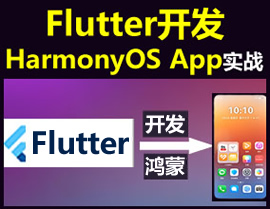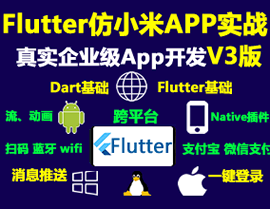Flutter原生标签栏插件native_tab_bar的使用
Flutter原生标签栏插件native_tab_bar的使用
可访问的标签导航栏插件适用于Flutter
此插件为Flutter提供了可访问、可自定义样式、本地化的底部标签导航组件,适用于Android和iOS平台。它几乎可以作为BottomNavigationBar Flutter小部件的直接替代品。在iOS上渲染UITabBar,在Android上渲染BottomNavigationView(与Material 3兼容)。其行为类似于BottomNavigationBarType.fixed,不提供典型的Flutter动画,而是尊重iOS和Android用户熟悉的本机平台行为和动画。
解决的无障碍问题
Flutter的BottomNavigationBar小部件存在一些无障碍问题。
-
iOS上的大内容查看器支持不足
- 由于空间限制,标签字体大小不应缩放,这给低视力用户造成了障碍。
-
iOS或Android上的标签角色或索引不正确
-
Flutter小部件标签的无障碍标签如下:“主页标签1/3”,“下载标签2/3”,“设置标签3/3”
-
它们应该被标记为:“主页”,“下载”,“设置”
-
Voice Control 在iOS上无法识别Flutter小部件。例如,如果用户说:“点击主页”,Voice Control不会识别该标签,因为它认为标签是“主页标签1/3”。即使用户说:“点击主页标签一/三”,Voice Control也无法识别。
-
盲文显示器用户 会因为较长的标签而感到困惑和不便,因为盲文显示器对标签有简短的表示方法,而这些标签却详细说明了它们。
-
此插件通过在各自的平台本地组件中提供本机iOS和Android行为来解决所有这些问题,以满足无障碍用户的需求。
安装
flutter pub add native_tab_bar依赖项
cupertino_iconsplugin_platform_interfaceuuidvisibility_detector
开发依赖项(仅在开发此插件时需要)
pigeon(用于API生成)
使用示例
完整的使用示例请参见example/lib/main.dart。
class HomePage extends StatefulWidget {
const HomePage({super.key});
[@override](/user/override)
State<HomePage> createState() => _HomePageState();
}
class _HomePageState extends State<HomePage> {
int currentTabIndex = 0;
[@override](/user/override)
Widget build(BuildContext context) {
return Scaffold(
appBar: AppBar(title: const Text('NativeTabBar Example')),
bottomNavigationBar: NativeTabBar(
onTap: (index) {
print("Selected tab index: $index");
setState(() {
currentTabIndex = index;
});
},
tabs: <NativeTab>[
NativeTab(
title: 'Home',
nativeTabIcon: NativeTabIcon.adaptive(
material: Icons.home, // 材质设计未选中图标
materialSelected: Icons.home_filled, // 材质设计选中图标
cupertino: CupertinoIcons.house, // iOS未选中图标
cupertinoSelected: CupertinoIcons.house_fill, // iOS选中图标
),
),
NativeTab(
title: 'Downloads',
nativeTabIcon: NativeTabIcon.adaptive(
material: Icons.download_outlined, // 材质设计未选中图标
materialSelected: Icons.download, // 材质设计选中图标
cupertino: CupertinoIcons.cloud_download, // iOS未选中图标
cupertinoSelected: CupertinoIcons.cloud_download_fill, // iOS选中图标
),
),
NativeTab(
title: 'Settings',
nativeTabIcon: NativeTabIcon.adaptive(
material: Icons.settings_outlined, // 材质设计未选中图标
materialSelected: Icons.settings, // 材质设计选中图标
cupertino: CupertinoIcons.gear_alt, // iOS未选中图标
cupertinoSelected: CupertinoIcons.gear_alt_fill, // iOS选中图标
),
),
],
style: NativeTabBarStyle(
selectedItemColor: Colors.lightBlue, // 选中标签的颜色
materialIndicatorBackgroundColor: Colors.lightBlue, // 材质设计指示器背景颜色
materialIndicatorForegroundColor: Colors.white, // 材质设计指示器前景颜色
),
),
body: Column(
mainAxisAlignment: MainAxisAlignment.start,
children: [
Padding(
padding: const EdgeInsets.all(8.0),
child: Text("Home page content goes here."),
),
],
),
);
}
}更多关于Flutter原生标签栏插件native_tab_bar的使用的实战系列教程也可以访问 https://www.itying.com/category-92-b0.html
native_tab_bar 是一个 Flutter 插件,用于在 Flutter 应用中创建原生风格的标签栏(Tab Bar)。它允许你在 iOS 和 Android 上使用平台原生的标签栏组件,从而提供更好的用户体验和性能。
安装插件
首先,你需要在 pubspec.yaml 文件中添加 native_tab_bar 插件的依赖:
dependencies:
flutter:
sdk: flutter
native_tab_bar: ^1.0.0 # 请使用最新版本然后运行 flutter pub get 来安装插件。
基本用法
以下是一个简单的示例,展示如何使用 native_tab_bar 插件创建一个带有两个标签页的标签栏。
import 'package:flutter/material.dart';
import 'package:native_tab_bar/native_tab_bar.dart';
void main() {
runApp(MyApp());
}
class MyApp extends StatelessWidget {
@override
Widget build(BuildContext context) {
return MaterialApp(
home: NativeTabBarExample(),
);
}
}
class NativeTabBarExample extends StatefulWidget {
@override
_NativeTabBarExampleState createState() => _NativeTabBarExampleState();
}
class _NativeTabBarExampleState extends State<NativeTabBarExample> {
int _selectedIndex = 0;
final List<Widget> _pages = [
Center(child: Text('Home Page')),
Center(child: Text('Settings Page')),
];
@override
Widget build(BuildContext context) {
return Scaffold(
body: _pages[_selectedIndex],
bottomNavigationBar: NativeTabBar(
currentIndex: _selectedIndex,
onTap: (index) {
setState(() {
_selectedIndex = index;
});
},
items: [
NativeTabBarItem(
icon: Icon(Icons.home),
title: Text('Home'),
),
NativeTabBarItem(
icon: Icon(Icons.settings),
title: Text('Settings'),
),
],
),
);
}
}参数说明
currentIndex: 当前选中的标签页索引。onTap: 当用户点击标签页时触发的回调函数,参数为被点击的标签页索引。items: 标签页的列表,每个标签页由NativeTabBarItem定义。icon: 标签页的图标。title: 标签页的标题。
自定义样式
native_tab_bar 插件允许你通过 NativeTabBarTheme 来自定义标签栏的样式。你可以在 MaterialApp 的 theme 中设置 nativeTabBarTheme 来全局应用样式,或者在 NativeTabBar 中直接设置 theme 来局部应用样式。
NativeTabBar(
currentIndex: _selectedIndex,
onTap: (index) {
setState(() {
_selectedIndex = index;
});
},
items: [
NativeTabBarItem(
icon: Icon(Icons.home),
title: Text('Home'),
),
NativeTabBarItem(
icon: Icon(Icons.settings),
title: Text('Settings'),
),
],
theme: NativeTabBarTheme(
backgroundColor: Colors.blue,
selectedItemColor: Colors.white,
unselectedItemColor: Colors.grey,
),
)






